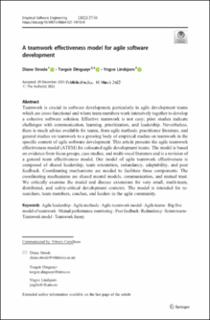| dc.description.abstract | Teamwork is crucial in software development, particularly in agile development teams which are cross-functional and where team members work intensively together to develop a cohesive software solution. Effective teamwork is not easy; prior studies indicate challenges with communication, learning, prioritization, and leadership. Nevertheless, there is much advice available for teams, from agile methods, practitioner literature, and general studies on teamwork to a growing body of empirical studies on teamwork in the specific context of agile software development. This article presents the agile teamwork effectiveness model (ATEM) for colocated agile development teams. The model is based on evidence from focus groups, case studies, and multi-vocal literature and is a revision of a general team effectiveness model. Our model of agile teamwork effectiveness is composed of shared leadership, team orientation, redundancy, adaptability, and peer feedback. Coordinating mechanisms are needed to facilitate these components. The coordinating mechanisms are shared mental models, communication, and mutual trust. We critically examine the model and discuss extensions for very small, multi-team, distributed, and safety-critical development contexts. The model is intended for re- searchers, team members, coaches, and leaders in the agile community. | en_US |

